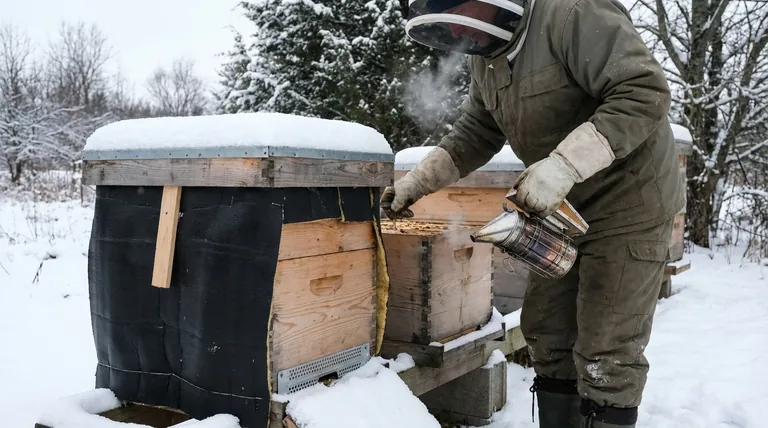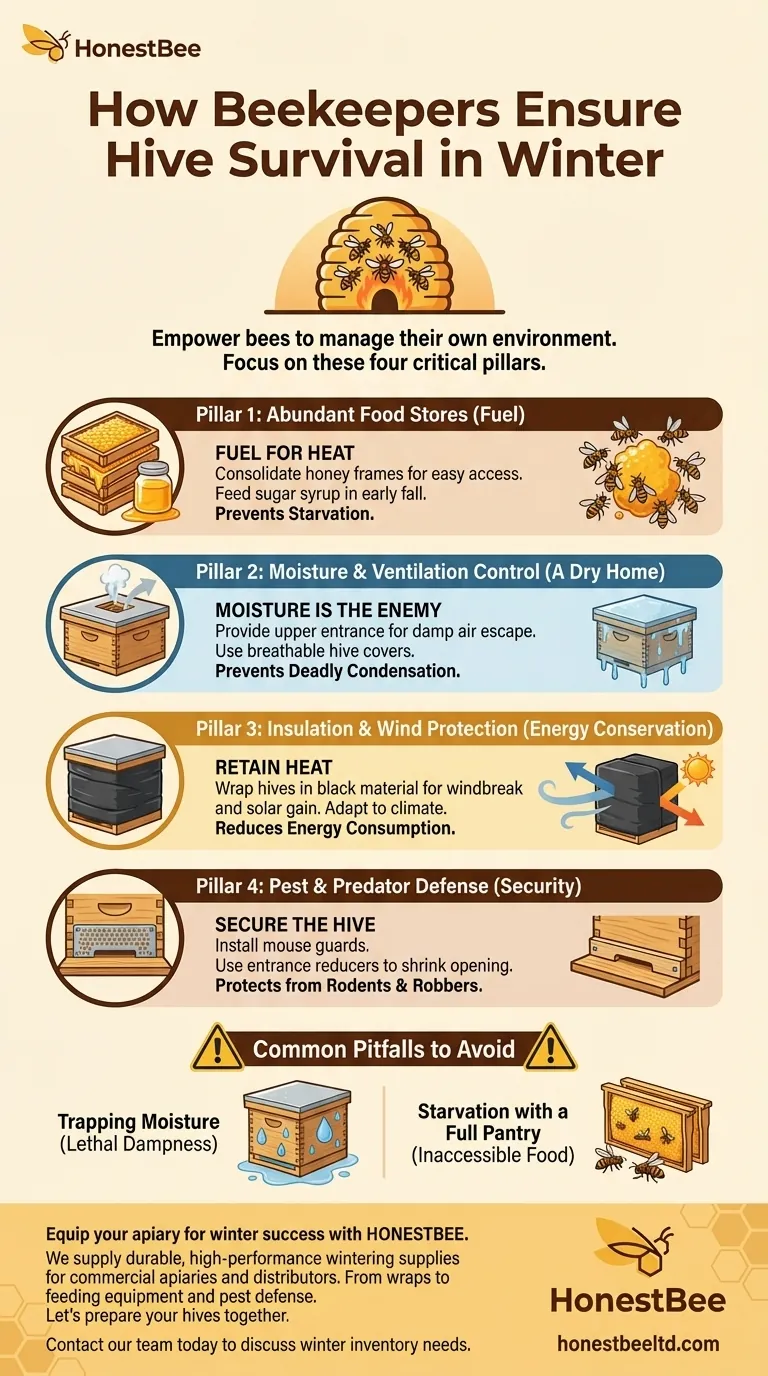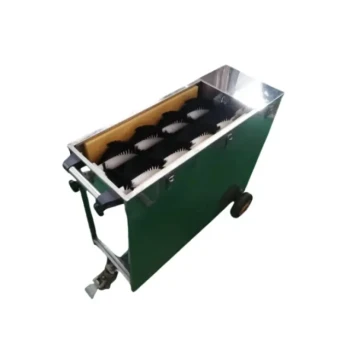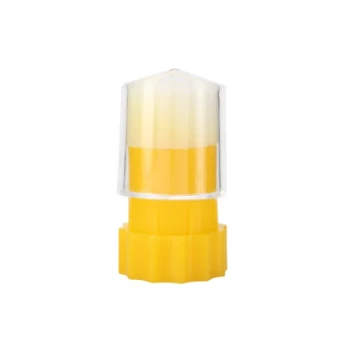To ensure your bees survive the winter, you must focus on four critical areas: guaranteeing ample food stores, managing moisture and ventilation, providing insulation and wind protection, and securing the hive against pests. Successful wintering is not a single action but a comprehensive strategy that begins long before the first frost, ensuring the colony is strong, well-fed, and housed in a dry, defensible space.
Your primary goal is not to heat the hive, but to empower the bees to efficiently manage their own environment. A dry, well-fed, and secure colony has all the tools it needs to generate and conserve its own heat, making external temperature a secondary concern.

The Four Pillars of Winter Hive Survival
A colony's ability to withstand winter rests on a few fundamental principles. Mastering these pillars transforms winter from a period of high risk to a predictable part of the beekeeping cycle.
Pillar 1: Abundant Food Stores (Fuel)
A winter cluster of bees generates heat by shivering, a process that consumes enormous amounts of energy. Honey is their fuel.
Starvation is a leading cause of winter colony death. A full, standard hive should have significant honey stores to last until spring nectar flows begin.
Beekeepers should consolidate honey frames into a single area. During deep cold, the bee cluster can be reluctant to move across empty frames, meaning they can starve even with honey just a few inches away.
If honey stores are light after the fall harvest, you must feed the colony with sugar syrup. This should be done early enough in the fall that the bees have time to process and cap it before cold weather sets in.
Pillar 2: Moisture and Ventilation Control (A Dry Home)
Moisture is more dangerous than cold. As the bees metabolize honey and cluster, their respiration releases warm, moist air. When this air hits a cold inner cover, it condenses and drips back down, chilling and killing the bees.
Proper ventilation is non-negotiable. Providing a small upper entrance, often included in hive wraps or created by placing a small shim under the inner cover, allows this moist air to escape.
A reliable beehive cover that prevents condensation buildup is also crucial. The goal is to let moisture out without creating a cold draft.
Pillar 3: Insulation and Wind Protection (Energy Conservation)
Insulation does not heat the hive; it helps the bees retain the heat they generate, reducing their energy consumption and preserving precious food stores.
Wrapping hives in black plastic or other specialized materials is a common practice. This wrap serves two purposes: it acts as a windbreak લોકોના and its dark color absorbs solar radiation, providing passive warmth on sunny days.
The choice of insulation material should be based on your geographical location. Hives in extremely cold climates benefit from more robust insulation, while those in milder areas may require less.
Pillar 4: Pest and Predator Defense (Security)
A wintering hive is a tempting target for rodents seeking warmth and food. Installing a mouse guard over the lower entrance is a simple but critical step to prevent invasion.
Bees are less able to defend their hive in the cold. An entrance reducer shrinks the size of the entrance, giving the colony a smaller, more defensible opening to protect against robbing from other insects or bees.
Understanding the Trade-offs and Common Pitfalls
Preparing a hive for winter involves balancing competing needs. Misunderstanding these trade-offs can lead to fatal mistakes.
The Danger of Trapping Moisture
In an effort to maximize warmth, some beekeepers mistakenly seal njihov hive too tightly. This is a critical error that traps moisture, creating a damp, cold environment that is far more lethal than a drafty but dry one. Always prioritize ventilation.
Forgetting Colony Health is the Engine
No amount of preparation can save a weak, diseased, or small colony. Winter success starts in the summer and fall by ensuring the queen is laying well and that pests, especially Varroa mites, are under control. A large, healthy population is the furnace that heats the hive.
Starvation with a Full Pantry
A common and tragic finding is a dead cluster of bees with frames of honey still in the hive. This happens when the honey is not consolidated, forcing the cluster to cross empty, cold space to reach food—a journey they often cannot make.
Making the Right Choice for Your Goal
Your specific winter strategy should be adapted to your climate and the state of your colony.
- If your primary focus is survival in a harsh, cold climate: Prioritize robust insulation, a solid windbreak, and ensuring the hive is absolutely packed with food stores.
- If your primary focus is navigating a milder, wetter climate: Emphasize moisture management and ventilation above all else, as condensation will be your biggest enemy.
- If your primary focus is protecting a smaller or weaker colony: Reduce the hive entrance efeitos to its smallest opening to prevent robbing and ensure food is placed directly adjacent to the existing cluster.
Ultimately, successful wintering is the direct result of proactive and thoughtful management.
Summary Table:
| Pillar | Key Action | Purpose |
|---|---|---|
| Food Stores | Consolidate honey frames; feed sugar syrup in fall | Prevent starvation by providing ample fuel for heat generation |
| Moisture Control | Provide upper ventilation; use a proper hive cover | Eliminate deadly condensation, which is more dangerous than cold |
| Insulation | Wrap hives for wind protection and solar gain | Help bees retain their own heat, conserving energy and food |
| Pest Defense | Install mouse guards and entrance reducers | Protect the vulnerable colony from rodents and robber bees |
Equip your apiary for winter success with HONESTBEE.
We supply commercial apiaries and beekeeping equipment distributors with the durable, high-performance supplies needed to implement these winter survival strategies effectively. From insulated hive wraps and ventilation components to essential feeding equipment and pest defenses, our wholesale-focused operations ensure you get the reliable gear your colonies depend on.
Let's prepare your hives together. Contact our team today to discuss your winter inventory needs.
Visual Guide

Related Products
- Wholesales Dadant Size Wooden Bee Hives for Beekeeping
- Adjustable Formic and Acetic Acid Dispenser for Bee Mite Treatment
- Professional Multi-Function Stainless Steel Hive Tool
- HONESTBEE Advanced Ergonomic Stainless Steel Hive Tool for Beekeeping
- Professional Insulated Winter Hive Wrap for Beekeeping
People Also Ask
- What are the essential pieces of equipment for most beekeepers? Get Started with the Right Gear
- What should you do if you find an ant nest near your beehive? Essential Strategies for Hive Protection
- What are the advantages of wooden bee hives? Superior Bee Health & Beekeeper Flexibility
- What is beekeeping equipment? Essential Tools for Commercial Apiaries & Distributors
- Why were wooden hives traditionally preferred? For Natural Beekeeping Aligned with Bee Biology



















